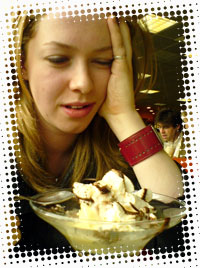 |
BlubberBusters Tips
from Lucy (Click here for past week's tips) |
|||
COMFORT EATINGUsing Food For Comfort
Sometimes you might use food to soothe or comfort a feeling or emotion even though you aren't hungry. This is called emotional or comfort eating. Comfort eating usually involves foods that are high in fat, sugar or salt, which can lead to weight gain. Yikes!! HERE'S HOW COMFORT EATING WORKS: You might feel sad (or some other emotion) and grab a bag of chips or candy and eat until all the chips or candy are gone. You might temporarily feel better while you are eating the food.The problem is that the comfort lasts only while you are eating the chips or candy. When the food is gone, the sadness or emotion returns, so you want to eat something more again to comfort yourself. You feel bad or disappointed in yourself because you know you will gain more weight from eating the food. This makes you more sad or disappointed in yourself and to comfort your feelings you eat more food and the cycle repeats. This is what is called a "VICIOUS CIRCLE" or a "VICIOUS CYCLE." Unfortunately, as you continue to use food for comfort, it becomes a habit and it gets more and more difficult to break the behavior. WHAT'S GOING ON IN MY BRAIN? When you eat for comfort, your brain actually changes to keep this behavior going. Eventually, it becomes such an ingrained habit that you can't stop, much like getting hooked on a drug or cigarettes. If you do try to stop, your brain reacts, and you feel really nervous, grouchy, or even more depressed. These reactions are called withdrawal symptoms. Withdrawal symptoms can be hard to deal with, but get better and usually go away within a few days. Comfort eating is an unhealthy coping mechanism but the good news is WE CAN LEARN TO COPE WITH OUR EMOTIONS WITHOUT USING FOOD FOR COMFORT. HERE ARE WAYS TO AVOID COMFORT EATING: 1. Identify Your Emotional Triggers & Make A Plan Ahead Of Time To Avoid It. Triggers are things or events that cause you to feel certain emotions. Watch for emotional triggers that might cause you to eat when you aren't hungry. Make a plan to avoid the trigger. Then when that emotion occurs, follow your plan. For example: My Trigger: I eat when I come home from school. My Plan: When I get home from school I will avoid the kitchen, go in my room, and turn on some favorite music to relax. My Trigger: I am bored on weekends. My Plan: I will draw out an activity from my distractions/Activities Jar and DO IT.My Trigger: I get stressed in math class. My Plan: Study my assignment and ask the teacher for help after class.
2. Use Your Distractions/Fun Activities Jar - Write down a fun activity you can do or like to do on a piece of paper and put in a small box or what we call a Distractions/Activities Jar.
Write down several fun things on separate pieces of paper and put in your distractions/activities jar. - When you experience one of your emotions and you feel the urge to eat, rather than eat, draw out one of the activities from your distraction jar and GO DO IT! - Remember, replacing food with activities/distractions is a HEALTHY WAY to cope with your emotion. 3. Enjoy a Pet Pets are great companions. Spending time with and caring for a pet is a great way to distract yourself from eating. 4. Get junk food out of the house! Out of site, out of mind! It's a good idea to remove junk food from your house, that way you won't be so tempted. Be mindful. THINK BEFORE YOU EAT! Are you really hungry? If not, DON'T EAT. THINK DISTRACT! 5. Surround yourself with SUPPORTIVE PEOPLE It sometimes helps to talk about why you feel the way you do. Talk to a You can also get lots of ideas and support from other kids on this site. Visit the Comfort Eating Board to learn how other kids deal with emotional eating. The chatroom, pre-teen, and teen bulletin boards are also great sources of help and information. You can interact with other kids and teens and read how they conquer their struggles with weight. Don't forget, every Wednesday "Lucy" is in the chat room to answer questions too!Time for a FUN DISTRACTION! HAVE FUN!!! And, don't forget to SMILE! You never know who's day you're making! Let us know what you think of this tip. Make this a healthy week! (Click here for past week's tips) |
||||
Please ask your
healthcare provider if these tips are right for you and please read our disclaimer.
 Sad? Depressed? Stressed? Angry? Nervous? Bored? Lonely? Afraid? These are all examples of common EMOTIONS that you might feel at various times.
Sad? Depressed? Stressed? Angry? Nervous? Bored? Lonely? Afraid? These are all examples of common EMOTIONS that you might feel at various times. These can be anything you like to do like: go for a walk, paint or draw a picture, relax with a good book, dance in your room, chat with a friend, help a neighbor, play the piano, keep a journal, and so forth.
These can be anything you like to do like: go for a walk, paint or draw a picture, relax with a good book, dance in your room, chat with a friend, help a neighbor, play the piano, keep a journal, and so forth. Not only do pets offer hours of enjoyment, they provide lots of comfort and love. If you can't have your own pet, you can still be around pets by volunteering at an animal shelter or offering to walk the neighbors dog.
Not only do pets offer hours of enjoyment, they provide lots of comfort and love. If you can't have your own pet, you can still be around pets by volunteering at an animal shelter or offering to walk the neighbors dog.
